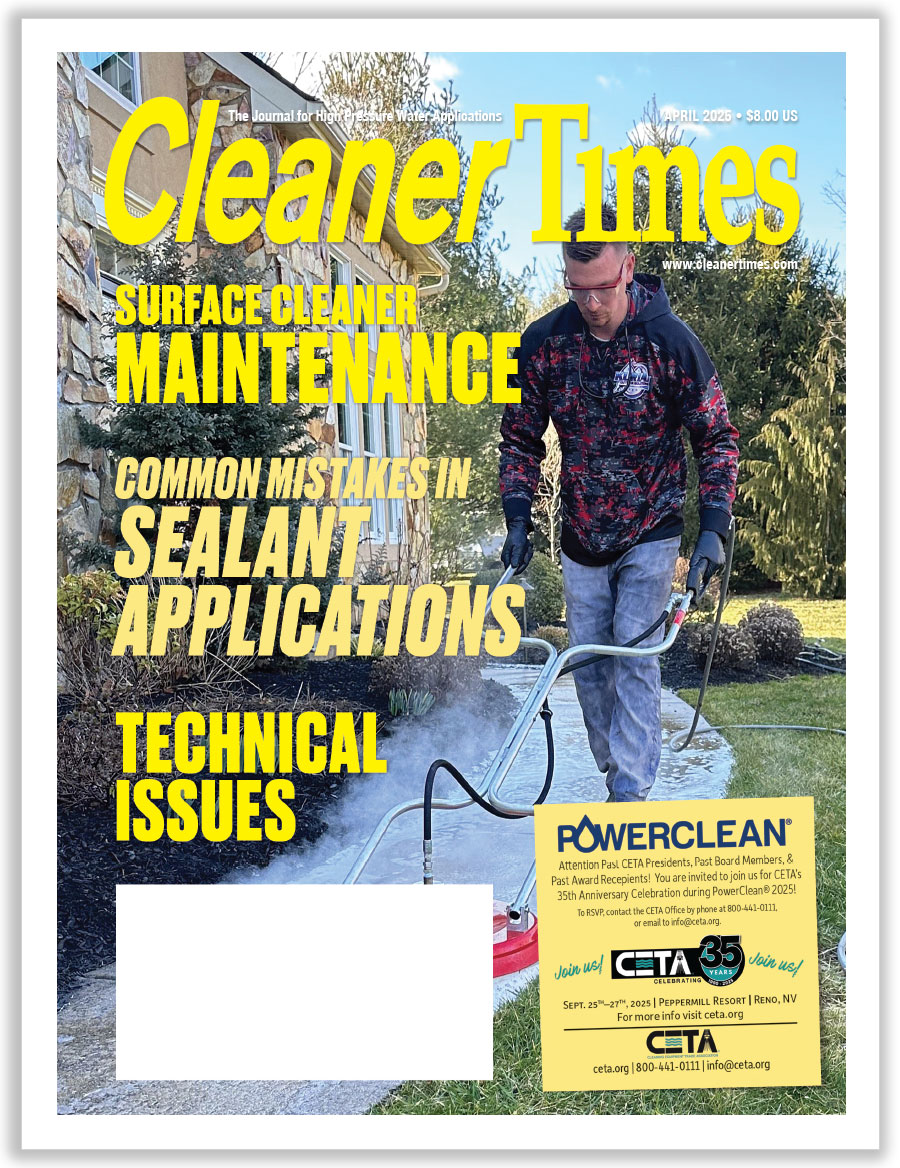
Maximizing Time and Profit
By Diane M. Calabrese / Published March 2023

ROI (Return on investment.) There is no confusion about what it means, or is there?
Whether it’s time or money invested in a business, there must be a return—a return that’s large enough to keep the business solvent.
Consequently, when perusing the abundance of books and articles about how to use time efficiently, the abundant advice can be perplexing. Yes, it’s a good idea to delegate, pause to refresh the spirit, and keep hours short so that one does not become depleted.
When a job must be finished, going the distance matters. It is wise to listen to the advice to promise and schedule no more than can be done.
Put in the realm of overpromising is the temptation to suggest something can be done that cannot. It’s a lie and waste of time to have images on a website that suggest a contractor provides certain services—working high, for example—when the contractor does not.
The images can land a contractor a higher insurance premium. If an insurer reviews the services—real or implied—advertised by a company, it may conclude the company’s workday includes more risk than it does, and attainment of a reasonably priced policy is in jeopardy.
Insurance does not come to mind at first when business owners think about maximizing the use of time and profit. But it should be in the mix of factors to consider.
A business owner may not be thinking about potential claims on a daily basis. In the course of time, it’s likely there will be some sort of claim.
Proof of insurance is almost always a requisite for obtaining a business license. And there are many options for meeting the requirement for liability coverage, which is fundamental. Leaping in and buying a policy if it’s reasonably priced might not be the best time saver in the long term.
“Always deal with an expert who knows the business,” says Tom Svrcek, president of CSC Insurance Options and Joseph D. Walters Insurance in Belle Vernon, PA. Doing so is the surest way to be certain that the protection obtained is the optimal protection for the business.
By dealing with an insurer with a deep knowledge of an industry, an insured party can also get the best advice possible on how to minimize risks. And minimizing risks to employees and property (including equipment) is a good way to conserve dollars and add to profit.
Since 1978, the company that Svrcek heads has offered an insurance program tailored to small companies in the power-washing industry. It knows the industry well.
Choosing vendors that know the industry well—or are willing to get to know it—is an important time and money saver. Talking to a vendor of accounting software or shipping logistics that wants to fit the client’s round pegs into its existing square holes can waste a lot of time.
The surest way to maximize time and profit is to be sure there is a return on the investment of every minute and every dollar to the fullest extent possible. Staying on track with that commitment requires having a goal.
Growth and more growth may not be the goal. Often, the goal is sustainability, a good steady stream of income that keeps a business solid across decades.
Sometimes the goal will change, but keeping it in sight is a must.
Right Sizing
R. Calvin Rasmussen, the CEO of Royce Industries L.C. in West Jordan, UT, puts “right sizing” on his list of ways to make the best use of time and to profit. He subordinates right sizing to the “technology” and “systems” that provide him with information he needs to make exacting decisions.
To be able to make the decisions when the economic climate may not be conducive to growth in any business is important. The foundation of good practices supported by the best technology and systems enables a business to respond quickly, explains Rasmussen.
Seeing a change in the economy coming, a company must be ready to respond. Suppose there is a downturn on the horizon; what’s the goal?
Rasmussen says his first goal as a family-owned company “is to do all possible to keep all our employees employed.” Accomplishing that begins with using the tools already in place.
“It may include more closely monitoring employee expenses—overtime, travel, vehicle, job supplies; controlling inventory levels; closer monitoring of cash—receivables and payables; and more,” says Rasmussen. And it also means suspending initiatives such as expansion in locations or staff.
On the flip side, should the economy be robust, expansion plans can be executed. Even then, though, they must be informed by metrics.
Count precise metrics as a superb way to maximize time and profit. “At our company, we have been working across four decades to improve upon our systems and best management practices,” explains Rasmussen.
Systems are not just retained because they are in place. “Systems that have stood the test of time are those that are developed with purpose, easily taught, easily understood, quantifiable and measurable, and—most importantly—repeatable,” says Rasmussen.
Among the systems that keep Rasmussen’s company aware of and responsive to industry and national economic conditions are onboarding/training; master quote templates; and management systems for territory, inventory, cash flow, work orders, and more. Benchmarking also contributes to the information stream.
One of the three original employees of his company, which was established (as Royce & Sons) in 1984, Rasmussen has quickly incorporated useful technology into the structure of the business. He reminisces about when “time-saving tools” like a Rolodex and day planner consolidated information, facilitating retrieval.
“Those early tools were eventually combined into one tool known as the Palm Pilot, and the rest is history,” says Rasmussen. Customer relationship management (CRM) software is now as close as a portable device.
“We have everything we need or want to know literally at our fingertips today,” says Rasmussen. “We are now able to maximize the use of our time better than ever.”
Prudent Investment
Cost cutting is not the same as selling more. But paring a budget, or at least pruning the wild and wasteful branches, can boost cash reserves that can be used to upgrade equipment or hire a new employee.
Achieving efficiency in all matters having to do with energy use may not produce enough savings for another staffer, but it will probably allow for at least one equipment upgrade. With fuel and power prices increasing, cutting consumption is a way to cut costs.
Take a couple of hours to brainstorm with the team about everywhere energy efficiency can improve. Maintain vehicles and HVAC. LED lighting uses 90 percent less energy than incandescent lighting, and it lasts at least 35 times longer (and two to five times longer than fluorescent).
Small things? Yes. But time and money saved can be invested elsewhere to boost profit.
What about AI? Much has been written and many awe-inspiring projections have been made about the lift it could give to businesses. In 2018 Anita Campbell, writing for the U.S. Small Business Administration (SBA.gov), reported on an Accenture Research study that concluded AI could boost profitability across all industries by 38 percent.
Perhaps. Right now, we are in the nickelodeon phase of AI—i.e., a situation akin to the first decade of the 20th century when everyone was guessing what would happen with film. Based on the shorts that people spent a nickel to see, some saw a movie industry growing and others saw no such thing.
One consistent complaint of customers seems to be bot-chat. They do not appreciate having their queries handled by scripted, rigid AI. As AI becomes more “intelligent,” that will probably change.
Maximizing time and profit might best be done in all matters by adopting the shortest-distance philosophy. Take the shortest distance—the fewest steps (literal and figurative)—between two points.
The long way around to a jobsite wastes time and money—easy to see. But there are plenty of places to cut those extra steps.
Take a company that has a high turnover in positions. The constant churn is costly. There are days when positions are unfilled, other workers are frustrated by an extra load, or a new hire must be trained.
Investing care in the hiring of each new employee boosts retention, and it also eliminates the do-over steps.
Order also saves steps. Whether it’s a service center or a service truck, any bit of disarray consumes time as an employee looks for something that is not where it should be. A solid system for organization also prevents wear and tear on equipment and tools that occur when storage is not done properly.
As for adding steps—time expended and cost incurred—there’s little to compare with procrastination. Doing nothing when there is something to be done means an accumulation of undone tasks.
The adage about not putting off until tomorrow what can be done today is an important one. It speaks to efficiency. Time passes even if we remain idle.
But idleness is not an investment in the future of anything, including a business. Idle hours drain life from people and businesses alike, so don’t neglect effective use of time—this most valuable asset.





